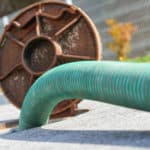Table of Contents
How to Know When Your Septic Tank is Full
You probably don’t think much about your septic tank. You know you’ve got one on your property and you probably had it inspected when you bought your house (or, at least you should have). If you’ve been in your home for a while, you may have had it emptied; if you haven’t been in your home long, maybe you haven’t. Even if you have had it emptied, it has probably faded from your memory or to do list since the last time you had it done. Every time you flush your toilet or run your laundry machine, you’re filling your septic tank, and sooner or later you’ll have to empty it. The problem is, how do you know when? Luckily, there are some easy ways to tell if your septic system is filling up so you can empty it before disaster strikes.
For starters, some terminology:
- Septic scum is the waste that floats on top of the water inside your septic tank.
- Septic sludge is the solids that sink to the bottom of your septic tank.
Four factors will influence the rate at which your tank fills up:
- The number of people in your household;
- The amount of water used in your house;
- The volume of solids in your wastewater;
- The size of your septic tank.
Below are seven signs that your septic system needs to be pumped:
It’s Time
This isn’t a sign so much as a rule, but it is the most important thing to remember about your septic system. Most septic tanks should be pumped every one to three years. This can vary depending on the size of your tank and frequency of use, and your septic service provider should be able to give you a specific schedule for your system. Whatever your schedule is, adhering to it can save you time, stress, and money.
Pooling Water
Large pools of water around the drain field of your septic system could mean it is overflowing. If you see pools of water around your drain field and it hasn’t rained, you should call your septic service provider. When your tank reaches capacity, solid waste can clog the drain field piping system and force liquid to the surface. If you see this, have your system pumped.
Slow Drains
If your home’s drains and toilet flushes remain slow after you take measures to unclog them, then your septic system may be full. It is good if you can catch the issue this early, as you will be able to pump your tank before something worse happens.
Odors
In addition to waste, your septic system collects gray water from showering, washing dishes, and doing laundry. As your septic tank fills, odor-causing gasses can emanate from your toilets, drains, outdoor septic tank area, or your drain field. If you notice strange odors inside or outside your house, it could indicate that your septic system is full and needs to be drained. It is best to do this immediately, as the odors are not only grossbut also unhealthy.
Your Lawn is Overly Healthy
The grass over your septic bed should resemble the grass on the rest of your lawn. If the grass over your septic bed appears overly green and lush, it could indicate your septic system is leaching liquids and needs to be pumped or checked for leaks.
High Nitrate Content in Well Water
If you have well water in addition to a septic system, you should test your water at least once a year. If the tests show higher than normal nitrate levels, your wastewater may be overflowing your septic system and leaching into your drinking water.
Sewer Backup
Sewer backup is the most obvious sign that your septic system needs to be pumped. If your sewer is backing up, your septic tank has reached capacity. Sewer backups will occur in the lowest drains first. If your sewer is backing up, call a professional immediately.
Septic systems are green and can save you a lot of money over local water and sewer charges you would alternatively be facing. Always use septic safe materials and cleaners, and stick to a pumping schedule to avoid costly surprises. It is helpful to be present for your septic pumping. Most service providers can inspect your tank as it is being pumped and let you know how well your system is working.




